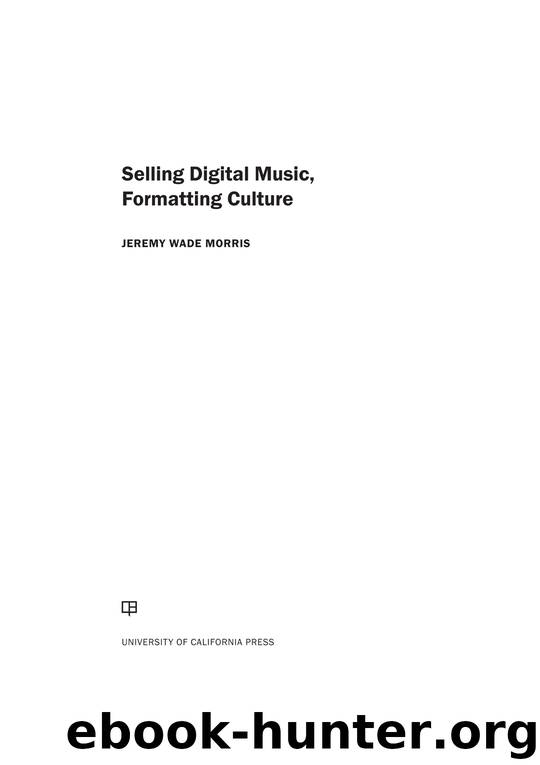Selling Digital Music, Formatting Culture by Jeremy Wade Morris

Author:Jeremy Wade Morris [Morris, Jeremy Wade]
Language: eng
Format: epub
ISBN: 9780520287938
Google: oh5SrgEACAAJ
Publisher: University of California Press
Published: 2015-07-30T20:46:05+00:00
4
Click to Buy
Music in Digital Stores
SELLING MUSIC ONLINE
When I first visited the SightSound Technologies website in 2006, I was greeted by a monkey, or rather, a black-and-white animated image of a chimpanzee with its mouth agape and a club in its hands. There was an automatic sound triggered, too, one that sounded like a computer starting up. It was a short crescendo, a rising sting that suggested something big was about to happen. The not-so-subtle nod to Stanley Kubrick’s 2001: A Space Odyssey in the splash page, logo, and sound design were meant to signal an evolutionary moment of significant proportion. The monkey has a tool; it has evolved. The logo faded and a crunchy guitar riff segued into a brief video detailing the company’s various contributions in the field of digital sight and sound technologies.
The first achievement SightSound claims is the sale of the first-ever digital music download online in September 1995: an album by Pittsburgh-based folk-rockers the Gathering Field (SightSound 1995). Users could buy the entire 634.2MB self-titled debut album for US$6.00, which took anywhere from twenty minutes to dozens of hours to download. Although Aerosmith had experimented with digital distribution for a song called “Head First” one year prior as a free download limited to CompuServe users (Haring 2000, 59), SightSound recognized the historical precedent they were setting: “That’s right, the entire disc [is] sold, then electronically delivered via the ’Net to the buyer. You can make history too. Order your own copy . . .” (SightSound, 1995–2002). For SightSound, users who purchased The Gathering Field weren’t just buying an album; they were taking part in a new way of buying music. Music retail was evolving.
SightSound—a “media eCommerce consulting” company with interests in audio and video distribution—hoped this new way of buying music would be exclusive to its company. Thanks to several patents it held, SightSound felt it had the sole right to sell and distribute digital music online. Company co-founder Arthur R. Hair had received a patent entitled “Method for Transmitting a Desired Digital Video or Audio Signal” in 1993 and a similar one in 1997, both for technology that facilitated the sale and download of audio and video files via phone lines and Internet connections (Hair 1993, 1997). In 1997 SightSound filed lawsuits against other online music retailers like CDNow and N2K that were starting to sell digital files of their own. The company sent letters to MP3.com (1998) and GoodNoise (1999), demanding a percentage from every digital sale those companies made (Lemos 1999). Since SightSound had patents on the technology for selling digital downloads, it argued the very method of selling digital downloads was, in essence, patentable. In other words, no other individual or company should have been able to sell digital music online without recognizing SightSound’s patent. As one of the co-founders said bluntly in an early interview: “We own digital download. We have won” (Newman 1999). Although SightSound promised more music from more artists in the future, and later claimed to have
Download
This site does not store any files on its server. We only index and link to content provided by other sites. Please contact the content providers to delete copyright contents if any and email us, we'll remove relevant links or contents immediately.
International Integration of the Brazilian Economy by Elias C. Grivoyannis(75773)
The Radium Girls by Kate Moore(11639)
Turbulence by E. J. Noyes(7717)
Nudge - Improving Decisions about Health, Wealth, and Happiness by Thaler Sunstein(7261)
The Black Swan by Nassim Nicholas Taleb(6786)
Rich Dad Poor Dad by Robert T. Kiyosaki(6195)
Pioneering Portfolio Management by David F. Swensen(6091)
Man-made Catastrophes and Risk Information Concealment by Dmitry Chernov & Didier Sornette(5672)
Zero to One by Peter Thiel(5507)
Secrecy World by Jake Bernstein(4406)
Millionaire: The Philanderer, Gambler, and Duelist Who Invented Modern Finance by Janet Gleeson(4116)
The Age of Surveillance Capitalism by Shoshana Zuboff(4001)
Skin in the Game by Nassim Nicholas Taleb(3980)
The Money Culture by Michael Lewis(3858)
Bullshit Jobs by David Graeber(3851)
Skin in the Game: Hidden Asymmetries in Daily Life by Nassim Nicholas Taleb(3738)
The Dhandho Investor by Mohnish Pabrai(3574)
The Wisdom of Finance by Mihir Desai(3539)
Blockchain Basics by Daniel Drescher(3342)
